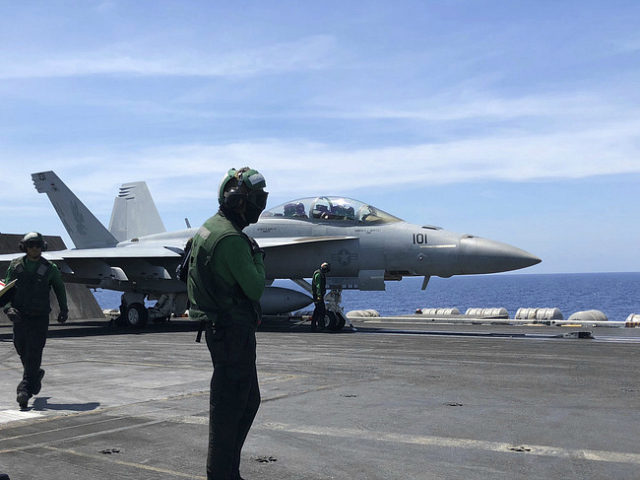The USS Theodore Roosevelt, a nuclear-powered super-carrier known by crew-members as the “Big Stick,” sailed through the disputed South China Sea this week, marking the latest display of America’s naval muscle in defiance of Beijing’s territorial claims in the region.
On Tuesday, the Associated Press (AP) reported:
As fighter jets streaked overhead, a U.S. aircraft carrier sailed through the disputed South China Sea on Tuesday in the latest display of America’s military might after China built a string of islands with military facilities to assert its claims in the strategic waters, sparking regional alarm.
…
Recent U.S. deployments of aircraft carriers, backed by destroyers, to the disputed waters for freedom of navigation challenges to Beijing’s territorial claims are reassuring allies but also prompting concerns with China’s own show of force in the busy waterway.
The U.S. Navy has deployed warships to the region at least twice this year.
This year, the USS Carl Vinson, a massive nuclear-powered aircraft carrier from which sailors dumped the bullet-ridden body of the late al-Qaeda leader Osama bin Laden, also flexed its muscle deep in the South China Sea amid U.S.-China tensions over Beijing’s territorial claims.
AP noted:
China has protested those moves [American naval presence], calling it U.S. meddling in an Asian conflict, and renewed warnings to Washington to stay away. Beijing has also reportedly been holding large-scale naval exercises in the area featuring its only operating aircraft carrier, while its air force says it recently sent some of its most advanced fighters and bombers for “joint combat patrols” over the sea.
China has been engaged in a contest over territorial control in the South China Sea with several Southeast Asian nations, including U.S allies.
Beijing claims “indisputable” ownership over all South China Sea islands and their adjacent waters, an allegation that impacts the territorial integrity of the other sovereign states in the region, namely Taiwan, Brunei, the Philippines, Malaysia, Vietnam, and Indonesia.
China has constructed artificial islands in the South China Sea capable of housing military installations, a move that drew the ire of the United States and countries in the region.
Reports of the USS Theodore Roosevelt navigating in the South China Sea came after an anonymous Pentagon official told the Wall Street Journal (WSJ), China has deployed military equipment capable of jamming communications and radars to its Spratly Island outposts.
On Monday, WSJ described the move as “a significant step in [China’s] creeping militarization of the South China Sea.”
“While China has maintained that the construction of the [artificial] islands [on the South China Sea] is to ensure safety at sea, navigation assistance, search and rescue, fisheries protection and other nonmilitary functions, electronic-jamming equipment is only for military use,” the Pentagon official noted.
Adm. Harry Harris, the top U.S. commander in the Pacific region, acknowledged that China’s military capabilities might soon “challenge” America’s military dominance in the Pacific region “across almost all domains.”

COMMENTS
Please let us know if you're having issues with commenting.